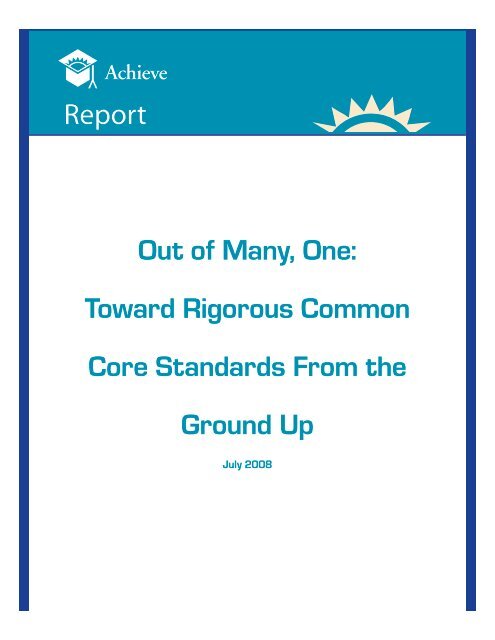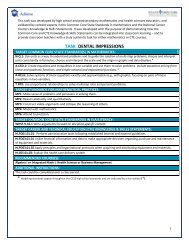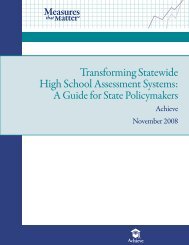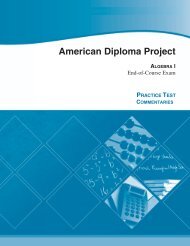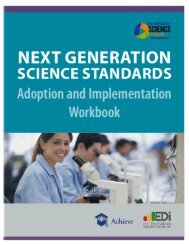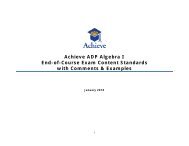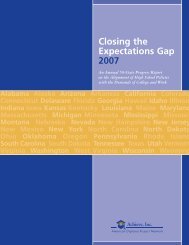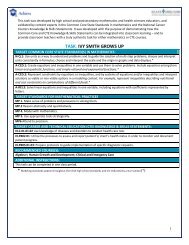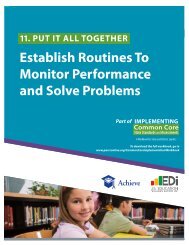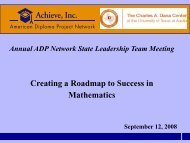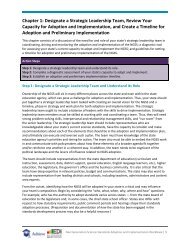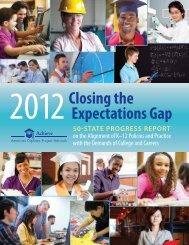Out of Many, One - Achieve
Out of Many, One - Achieve
Out of Many, One - Achieve
You also want an ePaper? Increase the reach of your titles
YUMPU automatically turns print PDFs into web optimized ePapers that Google loves.
Top 10 Tips from Experian QAS Tech SupportAugust 24, 2011Dial-in: 877-397-0300Passcode: 432527© 2011 Experian Information Solutions, Inc. All rights reserved. Experian and the marks used herein are service marks or registered trademarks <strong>of</strong> Experian Information Solutions, Inc.Other product and company names mentioned herein are the trademarks <strong>of</strong> their respective owners. No part <strong>of</strong> this copyrighted work may be reproduced, modified,or distributed in any form or manner without the prior written permission <strong>of</strong> Experian.
The ADP Network states have made considerable progress. Whereas only three states reported that theyhad aligned their high school standards with college and workplace demands before the Network was formed,today 22 states report that they have done so for English and mathematics. Ten other states are planning todo so this year. Whereas by the end <strong>of</strong> 2004, only two states had adopted policies that required students tocomplete a rigorous college- and career-prep curriculum in order to graduate, today 20 states and the District<strong>of</strong> Columbia have enacted such policies.The American Diploma Project BenchmarksFrom 2002 to 2004, in partnership with the Education Trust, the Thomas B. Fordham Foundation, and theNational Alliance <strong>of</strong> Business, <strong>Achieve</strong> worked closely with representatives from the K–12, postsecondaryand business communities in Indiana, Kentucky, Massachusetts, Nevada and Texas to identify the English andmathematics knowledge and skills high school graduates need for success in college and careers. As the firststep <strong>of</strong> the project, economists analyzed labor market projections to identify the most promising jobs—thosethat pay enough to support a family and provide real potential for career advancement—and reviewed highschool transcripts and other longitudinal education data to determine the preparation workers in thoseoccupations had received in high school. 2 ADP partnered with postsecondary faculty from two- and four-yearbroad-access institutions in the five partner states to determine the prerequisite English and mathematicsknowledge and skills required for success in entry-level, credit-bearing courses in English, mathematics, thephysical sciences, the social sciences and the humanities.An ambitious set <strong>of</strong> academic content standards reflecting the convergence <strong>of</strong> both employer andpostsecondary expectations, the ADP benchmarks, emerged from this research. 3 These college- and careerreadybenchmarks define the knowledge and skills in English and mathematics that all students must acquire inhigh school if they are to be prepared to meet the challenges that await them on college campuses and in theworkplace.In English, the ADP benchmarks focus not only on literature and writing but also explicitly on reasoning, logicand communication skills. The English benchmarks demand strong oral and written communication skillsbecause these skills are staples in college classrooms and 21st century jobs. They also contain analytical andreasoning skills that formerly were associated with advanced or honors courses in high school <strong>of</strong>fered to aselect few. Today, however, colleges and employers agree that all high school graduates need these essentialskills to be prepared.In mathematics, the ADP benchmarks include number sense and numerical operations; algebra; geometry;data interpretation, statistics and probability; and mathematical reasoning. The mathematics benchmarksequate roughly to the body <strong>of</strong> knowledge and skills students should encounter in a four-year high schoolmathematics program that includes content typically taught in Algebra I, Geometry and Algebra II, as wellas data analysis, statistics and probability. 4 A fourth year <strong>of</strong> meaningful mathematics is considered criticalby college faculty and employers alike so that students continue to develop and hone their facility withmathematics.ACHIEVE REPORT: <strong>Out</strong> <strong>of</strong> <strong>Many</strong>, <strong>One</strong> 4
ADP Benchmarks: Cross-Disciplinary Pr<strong>of</strong>icienciesThe increasing demands <strong>of</strong> the global economy require that American high school studentsgraduate with the knowledge and skills necessary to succeed. To achieve success in college, theworkplace and life, American students must not only master important content, they must alsobe adept problem solvers and critical thinkers who can contribute and apply their knowledge andskills in novel contexts and unforeseen situations. They must be able to read complex texts, usewriting and research in sophisticated ways, and be mathematically and technologically fluent. Highschool graduates must also be able to work collegially in teams and be keenly aware <strong>of</strong> the rapidlychanging world around them.Students need a strong content foundation in order to master these sophisticated crossdisciplinarypr<strong>of</strong>iciencies. Cross-disciplinary pr<strong>of</strong>iciencies are, therefore, best taught in thecontext <strong>of</strong> rigorous courses in the foundational disciplines. The ADP benchmarks in English andmathematics include these critical pr<strong>of</strong>iciencies and provide the foundation for their development.Specifically, the ADP benchmarks include the following cross-disciplinary pr<strong>of</strong>iciencies:Research and Evidence Gathering. The ADP benchmarks call on students to be able to conductresearch and to utilize the research process to describe, summarize and synthesize informationor to solve problems. In college and in the workplace, young adults will be asked to sift throughinformation and make choices on a wide range <strong>of</strong> issues. The ability to conduct an inquiry andengage in a focused examination <strong>of</strong> information is critical.Critical Thinking and Decision Making. Whether interpreting a graph or a piece <strong>of</strong> informationaltext, high school graduates must be able to employ abstract and concrete reasoning to make andassess logical inferences, conclusions and predictions. The ADP benchmarks foster the abilityto analyze evidence and data to build arguments and strategize about possible solutions. Theyalso call on students to learn to make sound decisions that acknowledge and evaluate probability,uncertainty and risk.Communication and Teamwork. Today’s employers and postsecondary institutions need highschool graduates with a diverse set <strong>of</strong> communications skills. The ability to listen critically, makeoral presentations and write complex reports is key. The ADP benchmarks focus on developingthe skills to articulate and translate ideas and information with precision and coherence.Postsecondary classrooms and workplaces are also increasingly global meeting places where highschool graduates must be able to work, learn and collaborate with diverse individuals from variouscultures and religions. The ADP benchmarks call for self-directed students with the ability to listenand learn from others in order to reach common goals while respecting differences. They include afocus on understanding different viewpoints to reach consensus and work productively in teams.Media and Technology. A sophisticated workforce <strong>of</strong> lifelong learners must continuously adapt totechnology that is advancing every year and be able to recognize how best to utilize technologyefficiently and effectively. The ADP benchmarks call on students to be able to use the appropriateinformation and communications technologies to enhance comprehension, creativity andproductivity. They call on students to learn to assess and employ a variety <strong>of</strong> media and formats toevaluate, create and distribute information.ACHIEVE REPORT: <strong>Out</strong> <strong>of</strong> <strong>Many</strong>, <strong>One</strong> 5
The ADP CoreDuring the original ADP research, college faculty and employers highlighted two categories <strong>of</strong> criticalshortcomings in the preparation <strong>of</strong> many recent high school graduates. The first was deficiency in the specificand narrow foundational skills typically taught in middle school. The other was a lack <strong>of</strong> complex and conceptualcompetencies acquired late in high school that take students several years to develop. While helping statesalign their standards to college- and career-ready expectations, <strong>Achieve</strong> has heard these same concernsechoed across the country.Based on these insights and <strong>Achieve</strong>’s extensive experience evaluating state standards, <strong>Achieve</strong> contentexperts have identified within the ADP benchmarks a core set <strong>of</strong> essential understandings that states mustinclude in their standards if they are to address these critical gaps and ensure that their graduates are wellprepared for college and careers. Although a well prepared high school graduate will have mastered all <strong>of</strong> theknowledge and skills found in the ADP benchmarks, the “ADP Core” contained within the benchmarks representa vital subset <strong>of</strong> college- and career-ready expectations and form the basis for the analysis in this report.There are 22 ADP Core English Benchmarks that cut across the eight strands <strong>of</strong> the ADP Benchmarks:language, communication, writing, research, logic, informational text, media and literature. The ADP Corein English includes important foundational skills such as using proper grammar, punctuation and spelling.In addition, it covers traditional expectations such as interpreting significant works from various genres <strong>of</strong>literature and informational materials. It also includes critical skills such as developing an argument, discerningthe nuances <strong>of</strong> an issue by analyzing information gleaned from multiple sources, and participating productivelyin self-directed work teams, all <strong>of</strong> which pr<strong>of</strong>essors and employers cite as critical for success in college andgood jobs.There are 34 ADP Core Mathematics Benchmarks that cut across the five ADP strands: number sense andnumerical operations; algebra; geometry; data interpretation, statistics and probability; and mathematicalreasoning. The ADP Core in mathematics calls for students to master the foundational computational skills andto recognize and solve problems that can be represented by various types <strong>of</strong> equations. The ADP Core extendsbeyond the expectation <strong>of</strong> fluent procedural skills by emphasizing the importance <strong>of</strong> students being able toidentify real world problems that can be solved mathematically, translate these problems into mathematicalmodels, apply appropriate techniques to solve them, and interpret a solution in the context <strong>of</strong> the problem.The mathematical reasoning inherent in applying geometric properties to solve problems, prove theoremsand perform constructions is also emphasized, as are key concepts in data interpretation, statistics andprobability.ACHIEVE REPORT: <strong>Out</strong> <strong>of</strong> <strong>Many</strong>, <strong>One</strong> 6
TABLE 1: ADP CORE IN EnglisHThere are 22 ADP Core English Benchmarks that cut across the eight strands <strong>of</strong> the ADPBenchmarks: language, communication, writing, research, logic, informational text, media andliterature. The ADP Core in English includes important foundational skills such as using propergrammar, punctuation and spelling. In addition, it covers traditional expectations such asinterpreting significant works from various genres <strong>of</strong> literature and informational materials. Italso includes critical skills such as developing an argument, discerning the nuances <strong>of</strong> an issue byanalyzing information gleaned from multiple sources, and participating productively in self-directedwork teams, all <strong>of</strong> which pr<strong>of</strong>essors and employers cite as critical for success in college and goodjobs.A. LanguageA1. Demonstrate control <strong>of</strong> standard English through the use <strong>of</strong> grammar, punctuation, capitalization andspelling.A6. Recognize nuances in the meanings <strong>of</strong> words; choose words precisely to enhance communication.A7. Comprehend and communicate quantitative, technical and mathematical information.B. CommunicationB4. Identify the thesis <strong>of</strong> a speech and determine the essential elements that elaborate it.B6. Make oral presentations.B7. Participate productively in self-directed work teams for a particular purpose.C. WritingC2. Select and use formal, informal, literary or technical language appropriate for the purpose, audience andcontext <strong>of</strong> the communication.C3. Organize ideas in writing with a thesis statement in the introduction, well-constructed paragraphs, aconclusion and transition sentences that connect paragraphs into a coherent whole.C9. Write an academic essay.C10. Produce work-related texts.D. ResearchD5. Write an extended research essay (approximately six to 10 pages), building on primary and secondarysources.E. LogicE1. Distinguish among facts and opinions, evidence and inferences.E4. Evaluate the range and quality <strong>of</strong> evidence used to support or oppose an argument.E8. Analyze two or more texts addressing the same topic to determine how authors reach similar ordifferent conclusions.E9. Construct arguments (both orally and in writing).F. Informational TextF2. Identify the main ideas <strong>of</strong> informational text and determine the essential elements that elaborate them.F5. Interpret and use information in maps, charts, graphs, time lines, tables and diagrams.F7. Synthesize information from multiple informational and technical sources.G. MediaG1. Evaluate the aural, visual and written images and other special effects used in television, radio, film andthe Internet for their ability to inform, persuade and entertain.G4. Apply and adapt the principles <strong>of</strong> written composition to create coherent media productions.H. LiteratureH3. Interpret significant works from various forms <strong>of</strong> literature.H8. Analyze the moral dilemmas in works <strong>of</strong> literature, as revealed by characters’ motivation and behavior.ACHIEVE REPORT: <strong>Out</strong> <strong>of</strong> <strong>Many</strong>, <strong>One</strong> 7
TABLE 2: ADP CORE IN MathematicsThere are 34 ADP Core Mathematics Benchmarks that cut across the five ADP strands: numbersense and numerical operations; algebra; geometry; data interpretation, statistics and probability;and mathematical reasoning. The ADP Core in mathematics calls for students to master thefoundational computational skills and to recognize and solve problems that can be representedby various types <strong>of</strong> equations. The ADP Core extends beyond the expectation <strong>of</strong> fluent proceduralskills by emphasizing the importance <strong>of</strong> students being able to identify real world problemsthat can be solved mathematically, translate these problems into mathematical models, applyappropriate techniques to solve them, and interpret a solution in the context <strong>of</strong> a problem.The mathematical reasoning inherent in applying geometric properties to solve problems,prove theorems and perform constructions is also emphasized, as are key concepts in datainterpretation, statistics and probability.I. Number Sense and Numerical OperationsI1.1. Add, subtract, multiply and divide integers, fractions and decimals.I1.3. Use the correct order <strong>of</strong> operations to evaluate arithmetic expressions, including those containingparentheses.I2. Recognize and apply magnitude (absolute value) and ordering <strong>of</strong> real numbers.I4.1. Use calculators appropriately and make estimations without a calculator regularly to detect potentialerrors.J. AlgebraJ1.1. Understand the properties <strong>of</strong> integer exponents and roots and apply these properties to simplifyalgebraic expressions.J2.3. Understand functional notation and evaluate a function at a specified point in its domain.J3.1 Solve linear equations and inequalities in one variable including those involving the absolute value <strong>of</strong> alinear function.J3.3. Solve systems <strong>of</strong> two linear equations in two variables.J3.5. Solve quadratic equations in one variable.J4.1. Graph a linear equation and demonstrate that it has a constant rate <strong>of</strong> change.J4.5. Graph a quadratic function and understand the relationship between its real zeros and the x-intercepts<strong>of</strong> its graph.J4.7. Graph exponential functions and identify their key characteristics.J4.8. Read information and draw conclusions from graphs; identify properties <strong>of</strong> a graph that provide usefulinformation about the original problem.J5.1. Recognize and solve problems that can be modeled using a linear equation in one variable, such astime/rate/distance problems, percentage increase or decrease problems, and ratio and proportionproblems.J5.3. Recognize and solve problems that can be modeled using a quadratic equation, such as the motion <strong>of</strong>an object under the force <strong>of</strong> gravity.J5.4. Recognize and solve problems that can be modeled using an exponential function, such as compoundinterest problems.ACHIEVE REPORT: <strong>Out</strong> <strong>of</strong> <strong>Many</strong>, <strong>One</strong> 8
TABLE 2 (Continued): ADP CORE IN MathematicsK. GeometryK1.2. State and prove key basic theorems in geometry such as the Pythagorean theorem, the sum <strong>of</strong> theangles <strong>of</strong> a triangle is 180 degrees, and the line joining the midpoints <strong>of</strong> two sides <strong>of</strong> a triangle is parallel tothe third side and half its length.K2.1. Identify and apply properties <strong>of</strong> and theorems about parallel lines and use them to prove theoremssuch as two lines parallel to a third are parallel to each other and to perform constructions such as a lineparallel to a given line through a point not on the line.K2.2. Identify and apply properties <strong>of</strong> and theorems about perpendicular lines and use them to provetheorems such as the perpendicular bisectors <strong>of</strong> line segments are the set <strong>of</strong> all points equidistant from thetwo end points and to perform constructions such as the perpendicular bisector <strong>of</strong> a line segment.K3. Know the basic theorems about congruent and similar triangles and use them to prove additionaltheorems and solve problems.K7. Know about the similarity <strong>of</strong> figures and use the scale factor to solve problems.K8.1. Understand that numerical values associated with measurements <strong>of</strong> physical quantities must beassigned units <strong>of</strong> measurement or dimensions; apply such units correctly in expressions, equationsand problem solutions; and convert a measurement using one unit <strong>of</strong> measurement to another unit <strong>of</strong>measurement.K8.2. Determine the perimeter <strong>of</strong> a polygon and the circumference <strong>of</strong> a circle; the area <strong>of</strong> a rectangle, acircle, a triangle and a polygon with more than four sides by decomposing it into triangles; the surface area<strong>of</strong> a prism, a pyramid, a cone and a sphere; and the volume <strong>of</strong> a rectangular box, a prism, a pyramid, a coneand a sphere.K10. Represent geometric objects and figures algebraically using coordinates; use algebra to solvegeometric problems.K11.2 Apply the trigonometric functions sine, cosine and tangent to solve for an unknown length <strong>of</strong> a side <strong>of</strong> aright triangle, given one <strong>of</strong> the acute angles and the length <strong>of</strong> another side.L. Data Interpretation, Statistics and ProbabilityL1.1. Organize and display data using appropriate methods (including spreadsheets) to detect patterns anddepartures from patterns.L1.2. Read and interpret tables, charts and graphs.L1.3. Compute and explain summary statistics for distributions <strong>of</strong> data including measures <strong>of</strong> center (mean,median) and spread (range, percentiles, variance, standard deviation).L2.1. Evaluate reports based on data published in the media by considering the source <strong>of</strong> the data, the design<strong>of</strong> the study, and the way data are analyzed and displayed.L3.4. Construct a scatter plot <strong>of</strong> a set <strong>of</strong> paired data, and if it demonstrates a linear trend, use a graphingcalculator to find the regression line that best fits this data; recognize that the correlation coefficientmeasures goodness <strong>of</strong> fit and explain when it is appropriate to use the regression line to make predictions.L4.5. Apply probability concepts to practical situations to make informed decisions.MR. Mathematical ReasoningMR3. Understanding the role <strong>of</strong> definitions, pro<strong>of</strong>s and counterexamples in mathematical reasoning;constructing simple pro<strong>of</strong>s.MR4. Using the special symbols <strong>of</strong> mathematics correctly and precisely.MR8. When solving problems, thinking ahead about strategy, testing ideas with special cases, tryingdifferent approaches, checking for errors and reasonableness <strong>of</strong> solutions as a regular part <strong>of</strong> routine work,and devising independent ways to verify results.ACHIEVE REPORT: <strong>Out</strong> <strong>of</strong> <strong>Many</strong>, <strong>One</strong> 9
Early AdoptersThis report highlights results <strong>of</strong> the standards revision process <strong>of</strong> 16 ADP states that together educate 38percent <strong>of</strong> public school students in the United States. 5 Eleven <strong>of</strong> these states—Arizona, Arkansas, Georgia,Louisiana, Maryland, Michigan, Minnesota, New Jersey, New Mexico, Oklahoma and Tennessee—participated inthe Alignment Institute process described above. The remaining five—Indiana, Kentucky, Ohio, Rhode Island andTexas—did not participate in the <strong>Achieve</strong> Alignment Institute but instead worked independently to revise theirstandards.Early AdoptersCAORWANVIDUTMTWYCONDSDNEKSMN*IAMOWIILMIOHINKYWVVT NH MENYRIPA CTNJDEMDVA DCMAAZ*NM*OKARTNNCSCAKTX*LAMSALGAFLLEGENDIndependent WorkAlignment Institute* Math alignment onlyHIIn the first section <strong>of</strong> the findings, we explore how well 12 states’ college- and career-ready standards inEnglish and 16 in mathematics align with the ADP Core <strong>of</strong> the ADP benchmarks—including a “before and after”comparison <strong>of</strong> the standards from states working with <strong>Achieve</strong> through the Alignment Institute process. 6 In thesecond section, we evaluate the extent to which the ADP Core is, in fact, common across the states. In the finalsection <strong>of</strong> the report, we discuss the key implications <strong>of</strong> this emerging common core.ACHIEVE REPORT: <strong>Out</strong> <strong>of</strong> <strong>Many</strong>, <strong>One</strong> 11
THE ALIGNMENT OF STATE STANDARDS TO THE ADP COREMethodology<strong>Achieve</strong> reviewed the new state college- and career-ready standards to determine how well they align to theADP benchmarks in general and the ADP Core in particular. Included in the analysis are the mathematicsstandards from 16 states and the English standards from 12. The remaining four states have not yet alignedtheir English standards.In conducting each standards review, three to four recognized content experts used pr<strong>of</strong>essional judgmentto respond to a set <strong>of</strong> guiding questions focused around the issue <strong>of</strong> alignment. <strong>Achieve</strong>’s content expertsrated the strength <strong>of</strong> the “match” <strong>of</strong> each state standard statement to the best fit in the ADP Core. For eachindividual standard reviewed, <strong>Achieve</strong> reconciled any discrepancies among the ratings assigned by the individualcontent experts to produce a consensus rating.RATING SCALEStandardAlignedStandardNotAligned3 = Excellent alignment between the state standard and at least one ADP benchmark2 = Good alignment, but elements <strong>of</strong> the ADP benchmark are not addressed1 = Weak match; the two statements may be related in only a very general manner0 = No match for the ADP benchmark was found<strong>Achieve</strong> then produced an average rating for all <strong>of</strong> the state standards collectively to calculate the overallstrength <strong>of</strong> their alignment to the ADP Core, an average rating for each set <strong>of</strong> state standards and an averagerating for each content strand. See Tables 3 and 4 for these ratings.For the Alignment Institute states, a “baseline” rating indicates the strength <strong>of</strong> a state’s standards alignmentto the ADP Core prior to beginning the Alignment Institute; the “final” rating describes the strength <strong>of</strong>alignment after the alignment process. Because the five states that worked independently <strong>of</strong> <strong>Achieve</strong> did notcomplete the Alignment Institute process, no baseline analysis was done; only their “final” alignment ratings areincluded in this report.Alignment by Content AreaEnglishOverall, the alignment <strong>of</strong> the English standards to the ADP Core is quite strong. On average, the alignmentrating across all 12 state standards included in this report is 2.60, indicating that they are well aligned.Among the strands, Writing and Informational Text have the strongest alignment to college- and career-readyexpectations, with average ratings <strong>of</strong> 2.90 and 2.81 respectively. The average rating for the Communicationsstrand—good at 2.18—is the lowest among the English strands.ACHIEVE REPORT: <strong>Out</strong> <strong>of</strong> <strong>Many</strong>, <strong>One</strong> 12
The Alignment Institute states increased the rigor <strong>of</strong> their English standards from their baseline ratings totheir final ratings, especially in the areas <strong>of</strong> Literature and Informational Text. In the baseline review theiraverage alignment rating across all strands was 2.08. By the end <strong>of</strong> the Alignment Institute process, theiraverage rating had increased to 2.75, an improvement <strong>of</strong> two-thirds <strong>of</strong> a point. Maryland and New Jersey sawthe greatest increases—nearly 1.25 points each. Georgia and Tennessee emerged with the highest overallalignment ratings <strong>of</strong> 2.96 and 3.00 respectively, reflecting the fact that both sets <strong>of</strong> new college- and careerreadystandards include all <strong>of</strong> the ADP Core.The English standards <strong>of</strong> the Alignment Institute states are on average more aligned to the ADP Core thanthose <strong>of</strong> the four states that worked independently—a difference <strong>of</strong> roughly half a point (.45). The mostpronounced difference in the alignment ratings between these two groups <strong>of</strong> states is in the Communicationsstrand. There is almost no difference in the average alignment ratings between the two groups <strong>of</strong> states in theWriting and Informational Text strands.ACHIEVE REPORT: <strong>Out</strong> <strong>of</strong> <strong>Many</strong>, <strong>One</strong> 13
TABLE 3: Alignment Ratings for English by Strand ◊G. Media H. Literature AverageF. InformationalTextC. Writing D. Research E. LogicB.CommunicationStrand A. LanguageALIGNMENT INSTITUTE STATESStates Baseline Final Baseline Final Baseline Final Baseline Final Baseline Final Baseline Final Baseline Final Baseline Final Baseline FinalAR † 2.00 2.00 1.00 2.00 2.75 3.00 1.00 1.00 2.25 2.50 1.67 2.67 2.50 2.50 1.50 1.50 1.83 2.15GA 3.00 3.00 2.33 3.00 3.00 3.00 3.00 3.00 3.00 3.00 2.67 2.67 3.00 3.00 1.50 3.00 2.69 2.96LA 2.00 2.67 2.67 3.00 2.75 3.00 3.00 3.00 1.50 2.00 1.67 3.00 1.50 3.00 1.50 3.00 2.07 2.83MD 2.00 3.00 1.00 3.00 2.00 2.75 2.00 3.00 2.25 3.00 1.67 2.67 1.00 2.50 1.00 3.00 1.62 2.86MI 1.67 3.00 3.00 3.00 2.50 2.50 3.00 3.00 2.25 3.00 1.67 3.00 3.00 3.00 3.00 3.00 2.51 2.94NJ 1.67 3.00 2.33 2.67 2.00 2.50 1.00 2.00 1.50 2.50 1.00 3.00 0.50 2.50 1.00 3.00 1.38 2.65OK 3.00 3.00 1.00 1.00 3.00 3.00 3.00 3.00 2.50 2.50 2.67 2.67 3.00 3.00 2.50 2.50 2.58 2.58TN 2.67 3.00 1.33 3.00 2.75 3.00 2.00 3.00 1.50 3.00 2.00 3.00 3.00 3.00 0.50 3.00 1.97 3.00Average 2.25 2.83 1.83 2.58 2.59 2.84 2.25 2.63 2.09 2.69 1.88 2.83 2.19 2.81 1.56 2.75 2.08 2.75STATES THAT WORKED INDEPENDENTLYStates Baseline Final Baseline Final Baseline Final Baseline Final Baseline Final Baseline Final Baseline Final Baseline Final Baseline FinalIN * 1.50 * 3.00 * 3.00 * 3.00 * 3.00 * 3.00 * 2.33 * 3.00 * 2.73KY * 3.00 * 2.50 * 3.00 * 2.00 * 1.00 * 2.50 * 2.33 * 2.00 * 2.29OH * 3.00 * 0.00 * 3.00 * 2.50 * 3.00 * 2.75 * 2.00 * 1.67 * 2.24RI * 1.50 * 0.00 * 3.00 * 1.75 * 1.00 * 2.75 * 2.67 * 3.00 * 1.96Average * 2.25 * 1.38 * 3.00 * 2.31 * 2.00 * 2.75 * 2.33 * 2.42 * 2.30AVERAGE ALIGNMENT RATING FOR ALL TWELVE STATESOverallAverage2.64 2.18 2.90 2.52 2.46 2.81 2.65 2.64 2.60◊ While there are differences in alignment strand scores and overall average scores within and across states, <strong>Achieve</strong> found thestandards in all <strong>of</strong> the states reviewed to be “well aligned” or ”well aligned with minor exceptions” to the ADP benchmarks.* <strong>Achieve</strong> did not conduct a baseline review for states that did not participate in the Alignment Institute.† Because Arkansas conducted its standards review midcycle, it was limited in the extent to which it could make revisions. Thenext revision is scheduled for 2010. Nevertheless, <strong>Achieve</strong> found Arkansas’ English and mathematics standards to be “well alignedwith minor exceptions” to the ADP benchmarks.ACHIEVE REPORT: <strong>Out</strong> <strong>of</strong> <strong>Many</strong>, <strong>One</strong> 14
MathematicsOverall, the alignment <strong>of</strong> the mathematics standards to the ADP Core is quite strong. The average alignment ratingacross the 16 state standards in mathematics is 2.63. The Algebra and Geometry strands earned the highestalignment ratings <strong>of</strong> 2.85 and 2.79 respectively. The Mathematical Reasoning strand—with an average rating <strong>of</strong> 2.19—is the lowest among the mathematics strands.The Alignment Institute states increased the rigor <strong>of</strong> their mathematics standards, especially in the Geometrystrand where they strengthened their treatment <strong>of</strong> geometric pro<strong>of</strong>s. The baseline rating across the states was2.28. This increased to 2.69 for the revised state standards. The five states that worked independently developedstandards with an overall alignment rating <strong>of</strong> 2.51, only slightly lower (.18) than that <strong>of</strong> the states that participated inthe Alignment Institute. Tennessee showed the greatest improvement and the strongest alignment to the ADP Corein mathematics after completing the Alignment Institute.TABLE 4: Alignment Ratings FOR MATHEMATICS by Strand ◊StrandI. Number Sense& NumericalOperationsJ. Algebra K. GeometryL. DataInterpretation,Statistics &ProbabilityALIGNMENT INSTITUTE STATESMR.MathematicalReasoningAverageStates Baseline Final Baseline Final Baseline Final Baseline Final Baseline Final Baseline FinalAZ 2.50 2.75 1.83 3.00 2.25 2.78 2.50 3.00 2.33 2.67 2.28 2.84AR † 2.13 3.00 2.92 3.00 2.08 3.00 2.33 2.50 0.00 1.33 1.89 2.57GA 2.63 2.63 2.92 2.92 2.78 2.89 2.33 2.50 3.00 3.00 2.73 2.79LA 2.13 2.50 3.00 3.00 2.17 2.53 2.17 2.17 0.67 3.00 2.03 2.64MD 2.38 2.88 2.17 2.83 2.31 2.89 2.00 2.83 2.33 1.67 2.24 2.62MI 2.25 2.25 2.92 2.83 2.67 2.67 3.00 3.00 1.00 1.00 2.37 2.35MN 2.50 3.00 2.58 3.00 2.03 3.00 2.50 3.00 1.67 2.00 2.26 2.80NJ 2.38 3.00 2.33 2.67 1.81 2.44 2.83 3.00 2.67 2.33 2.40 2.69NM 2.50 2.75 2.67 3.00 2.25 2.89 3.00 3.00 2.67 2.67 2.62 2.86OK 2.00 2.25 2.42 2.67 2.14 2.64 1.83 2.00 2.00 2.67 2.08 2.45TN 2.75 3.00 2.00 3.00 2.22 3.00 2.00 3.00 2.00 3.00 2.19 3.00Average 2.38 2.73 2.52 2.90 2.25 2.79 2.41 2.73 1.85 2.30 2.28 2.69STATES THAT WORKED INDEPENDENTLYStates Baseline Final Baseline Final Baseline Final Baseline Final Baseline Final Baseline FinalIN * 2.25 * 2.75 * 2.56 * 2.50 * 3.00 * 2.61KY * 2.25 * 3.00 * 2.33 * 1.50 * 0.00 * 1.82OH * 2.75 * 2.67 * 3.00 * 3.00 * 3.00 * 2.88RI * 2.63 * 2.67 * 3.00 * 2.67 * 0.67 * 2.33TX * 2.88 * 2.58 * 3.00 * 3.00 * 3.00 * 2.89Average * 2.55 * 2.73 * 2.78 * 2.53 * 1.93 * 2.51AVERAGE ALIGNMENT RATING FOR ALL SIXTEEN STATESOverallAverage2.67 2.85 2.79 2.67 2.19 2.63◊ While there are differences in alignment strand scores and overall average scores within and across states, <strong>Achieve</strong> foundthe standards in all <strong>of</strong> the states reviewed to be “well aligned” or ”well aligned with minor exceptions” to the ADP benchmarks.* <strong>Achieve</strong> did not conduct a baseline review for states that did not participate in the Alignment Institute.† Because Arkansas conducted its standards review midcycle, it was limited in the extent to which it could make revisions.The next revision is scheduled for 2010. Nevertheless, <strong>Achieve</strong> found Arkansas’ English and mathematics standards to be “wellaligned with minor exceptions” to the ADP benchmarks.ACHIEVE REPORT: <strong>Out</strong> <strong>of</strong> <strong>Many</strong>, <strong>One</strong> 15
THE ADP CORE IS THE COMMON COREThe ADP Core has become the “common core” as a byproduct <strong>of</strong> the alignment work in each <strong>of</strong> the states. AnADP Core benchmark is defined as “common” if at least 75 percent <strong>of</strong> the states include it in their standardswith an alignment rating <strong>of</strong> 2.00—i.e., “good” alignment—or better. The common core reflects the reality thatthe knowledge and skills needed for success in postsecondary education and 21st century careers are definedby global competition, not by state boundaries.EnglishAll but one <strong>of</strong> the 22 ADP Core benchmarks in English meet the criteria for the common core. They areincluded in at least nine <strong>of</strong> the 12 sets <strong>of</strong> state English standards with good or excellent alignment to collegeandcareer-ready expectations. The ADP Core benchmark that did not meet the criteria for the common coreinvolves working in teams. Only seven <strong>of</strong> the 12 states (58 percent) include working in teams in their standards,including only one <strong>of</strong> the four states working independently. This is a critically important skill for postsecondaryand workplace success.This common core <strong>of</strong> standards means that these states share rigorous expectations anchored in the realworld for all students. They expect students to graduate from high school with strong research and writingskills, with the ability to reason logically and to communicate complex ideas in a variety <strong>of</strong> ways. They expectstudents to develop a tolerance for ambiguity, read and use information contained in complex technical textsas well as consider moral dilemmas encountered in literature.MathematicsAll but three <strong>of</strong> the 34 ADP Core benchmarks in mathematics are included in the standards <strong>of</strong> at least12 <strong>of</strong> the 16 states included in this report and are found to be well aligned (rated 2.00 or better). Thethree benchmarks not included in the common core are found in 11 sets <strong>of</strong> state standards. <strong>One</strong> <strong>of</strong> thesebenchmarks expects students to improvise problem-solving strategies and devise independent ways to verifytheir results. Another calls for students to evaluate data reported in the media, a skill that will enable themto understand whether reports are fair and accurate, or contain misrepresentations and incomplete data.The third deals with a key aspect <strong>of</strong> geometric pro<strong>of</strong>s—specifically with perpendicular lines—critical to thedevelopment <strong>of</strong> a student’s logical reasoning skills.States that incorporate this common core into their standards set a high bar for their students. Studentswho graduate from high school will have procedural fluency in the foundational computational skills. They willpossess a solid understanding <strong>of</strong> the mathematical principles they encounter in the classroom. They will be ableto reason quantitatively and apply what they learn in the classroom to solve real world problems.ACHIEVE REPORT: <strong>Out</strong> <strong>of</strong> <strong>Many</strong>, <strong>One</strong> 16
TABLE 5: Common ADP Core in English# ADP Core TotalAlignmentInstituteStatesNon-AlignmentInstituteStatesA1Demonstrate control <strong>of</strong> standard English through the use <strong>of</strong> grammar,punctuation, capitalization and spelling.100% 100% 100%B6 Make oral presentations. 100% 100% 100%C2Select and use formal, informal, literary or technical language appropriatefor the purpose, audience and context <strong>of</strong> the communication.100% 100% 100%C3Organize ideas in writing with a thesis statement in the introduction,well-constructed paragraphs, a conclusion and transition sentences that 100% 100% 100%connect paragraphs into a coherent whole.C9 Write an academic essay. 100% 100% 100%E4Evaluate the range and quality <strong>of</strong> evidence used to support or oppose anargument.100% 100% 100%F2Identify the main ideas <strong>of</strong> informational text and determine the essentialelements that elaborate them.100% 100% 100%F5Interpret and use information in maps, charts, graphs, time lines, tables anddiagrams.100% 100% 100%F7 Synthesize information from multiple informational and technical sources. 100% 100% 100%H3 Interpret significant works from various forms <strong>of</strong> literature. 100% 100% 100%A6Recognize nuances in the meanings <strong>of</strong> words; choose words precisely toenhance communication.92% 100% 75%E1 Distinguish among facts and opinions, evidence and inferences. 92% 100% 75%E9 Construct arguments (both orally and in writing). 92% 100% 75%B4Identify the thesis <strong>of</strong> a speech and determine the essential elements thatelaborate it.92% 88% 100%G1Evaluate the aural, visual and written images and other special effects usedin television, radio, film and the Internet for their ability to inform, persuade 83% 100% 50%and entertain.G4Apply and adapt the principles <strong>of</strong> written composition to create coherentmedia productions.83% 100% 50%A7Comprehend and communicate quantitative, technical and mathematicalinformation.83% 88% 75%E8Analyze two or more texts addressing the same topic to determine howauthors reach similar or different conclusions.83% 75% 100%D5Write an extended research essay (approximately six to 10 pages), buildingon primary and secondary sources.75% 88% 50%H8Analyze the moral dilemmas in works <strong>of</strong> literature, as revealed bycharacters’ motivation and behavior.75% 88% 50%C10 Produce work-related texts. 75% 75% 75%B7Participate productively in self-directed work teams for a particularpurpose.58% 75% 25%ACHIEVE REPORT: <strong>Out</strong> <strong>of</strong> <strong>Many</strong>, <strong>One</strong> 17
TABLE 6: Common ADP Core in Mathematics# ADP Core TotalAlignmentInstituteStatesNon-AlignmentInstituteStatesI1.1 Add, subtract, multiply and divide integers, fractions and decimals. 100% 100% 100%J1.1Understand the properties <strong>of</strong> integer exponents and roots and apply theseproperties to simplify algebraic expressions.100% 100% 100%J2.3Understand functional notation and evaluate a function at a specified pointin its domain.100% 100% 100%J3.1Solve linear equations and inequalities in one variable including thoseinvolving the absolute value <strong>of</strong> a linear function.100% 100% 100%J3.3 Solve systems <strong>of</strong> two linear equations in two variables. 100% 100% 100%J3.5 Solve quadratic equations in one variable. 100% 100% 100%J4.5Graph a quadratic function and understand the relationship between itsreal zeros and the x-intercepts <strong>of</strong> its graph.100% 100% 100%J4.7 Graph exponential functions and identify their key characteristics. 100% 100% 100%J5.1Recognize and solve problems that can be modeled using a linear equationin one variable, such as time/rate/distance problems, percentage increase 100% 100% 100%or decrease problems, and ratio and proportion problems.K3Know the basic theorems about congruent and similar triangles and usethem to prove additional theorems and solve problems.100% 100% 100%K7Know about the similarity <strong>of</strong> figures and use the scale factor to solveproblems.100% 100% 100%K8.1Understand that numerical values associated with measurements <strong>of</strong>physical quantities must be assigned units <strong>of</strong> measurement or dimensions;apply such units correctly in expressions, equations and problem solutions; 100% 100% 100%and convert a measurement using one unit <strong>of</strong> measurement to another unit<strong>of</strong> measurement.K8.2Determine the perimeter <strong>of</strong> a polygon and the circumference <strong>of</strong> a circle;the area <strong>of</strong> a rectangle, a circle, a triangle and a polygon with more thanfour sides by decomposing it into triangles; the surface area <strong>of</strong> a prism, a 100% 100% 100%pyramid, a cone and a sphere; and the volume <strong>of</strong> a rectangular box, a prism,a pyramid, a cone and a sphere.K11.2Apply the trigonometric functions sine, cosine and tangent to solve for anunknown length <strong>of</strong> a side <strong>of</strong> a right triangle, given one <strong>of</strong> the acute angles 100% 100% 100%and the length <strong>of</strong> another side.L1.1Organize and display data using appropriate methods (includingspreadsheets) to detect patterns and departures from patterns.100% 100% 100%L1.2 Read and interpret tables, charts and graphs. 100% 100% 100%L1.3Compute and explain summary statistics for distributions <strong>of</strong> data includingmeasures <strong>of</strong> center (mean, median) and spread (range, percentiles, 100% 100% 100%variance, standard deviation).J4.8Read information and draw conclusions from graphs; identify properties <strong>of</strong>a graph that provide useful information about the original problem.94% 100% 80%ACHIEVE REPORT: <strong>Out</strong> <strong>of</strong> <strong>Many</strong>, <strong>One</strong> 18
TABLE 6 (Continued): Common ADP Core in Mathematics# ADP Core TotalNon-AlignmentAlignmentInstituteInstituteStatesStatesJ5.3Recognize and solve problems that can be modeled using a quadraticequation, such as the motion <strong>of</strong> an object under the force <strong>of</strong> gravity.94% 100% 80%J5.4Recognize and solve problems that can be modeled using an exponentialfunction, such as compound interest problems.94% 100% 80%L4.5Apply probability concepts to practical situations to make informeddecisions.94% 100% 80%I1.3Use the correct order <strong>of</strong> operations to evaluate arithmetic expressions,including those containing parentheses.94% 91% 100%I2Recognize and apply magnitude (absolute value) and ordering <strong>of</strong> realnumbers.94% 91% 100%J4.1Graph a linear equation and demonstrate that it has a constant rate <strong>of</strong>change.94% 91% 100%K1.2State and prove key basic theorems in geometry such as the Pythagoreantheorem, the sum <strong>of</strong> the angles <strong>of</strong> a triangle is 180 degrees, and the linejoining the midpoints <strong>of</strong> two sides <strong>of</strong> a triangle is parallel to the third side94% 91% 100%and half its length.K10Represent geometric objects and figures algebraically using coordinates:use algebra to solve geometric problems.94% 91% 100%K2.1Identify and apply properties <strong>of</strong> and theorems about parallel lines and usethem to prove theorems such as two lines parallel to a third are parallel toeach other and to perform constructions such as a line parallel to a given88% 100% 60%line through a point not on the line.L3.4Construct a scatter plot <strong>of</strong> a set <strong>of</strong> paired data, and if it demonstrates alinear trend, use a graphing calculator to find the regression line that bestfits this data; recognize that the correlation coefficient measures goodness 88% 91% 80%<strong>of</strong> fit and explain when it is appropriate to use the regression line to makepredictions.MR3Understanding the role <strong>of</strong> definitions, pro<strong>of</strong>s and counterexamples inmathematical reasoning; constructing simple pro<strong>of</strong>s.88% 91% 80%I4.1Use calculators appropriately and make estimations without a calculatorregularly to detect potential errors.81% 91% 60%MR4 Using the special symbols <strong>of</strong> mathematics correctly and precisely. 75% 82% 60%K2.2Identify and apply properties <strong>of</strong> and theorems about perpendicular linesand use them to prove theorems such as the perpendicular bisectors <strong>of</strong>line segments are the set <strong>of</strong> all points equidistant from the two end points 69% 73% 60%and to perform constructions such as the perpendicular bisector <strong>of</strong> a linesegment.L2.1Evaluate reports based on data published in the media by considering thesource <strong>of</strong> the data, the design <strong>of</strong> the study, and the way data are analyzed 69% 73% 60%and displayed.MR8When solving problems, thinking ahead about strategy, testing ideaswith special cases, trying different approaches, checking for errors andreasonableness <strong>of</strong> solutions as a regular part <strong>of</strong> routine work, and devisingindependent ways to verify results.69% 73% 60%ACHIEVE REPORT: <strong>Out</strong> <strong>of</strong> <strong>Many</strong>, <strong>One</strong> 19
Common does not mean identical state standardsWhile state standards from these states share a common core, they are not identical. The ADP Core formsa foundation <strong>of</strong> college- and career-ready expectations, but does not necessarily constitute four full years <strong>of</strong>content in English and mathematics. How states choose to construct a rich classroom experience for all fouryears <strong>of</strong> high school varies from state to state. A number <strong>of</strong> states include content in their standards that areoutside the scope <strong>of</strong>, or more rigorous than, the ADP benchmarks. For example, a number <strong>of</strong> states includein their mathematics standards rigorous content that is particularly important for students interested inpursuing further education and careers in Science, Technology, Engineering or Mathematics (STEM) fields.States also differ with respect to the organization <strong>of</strong> their standards, their level <strong>of</strong> specificity and the amount<strong>of</strong> detail provided. Most states organize secondary level standards into courses or course sequences (e.g.,Algebra I, Geometry and Algebra II; American Literature, British Literature and World Literature) while a fewothers organize the standards into grade spans (e.g., grades 9-10, 11-12). Standards for grade bands 9-10and 11-12 tend to identify and focus on the most significant knowledge and skills students must acquire by theend <strong>of</strong> each band. In contrast, course descriptions will <strong>of</strong> necessity be more comprehensive as they will—andshould—include the supporting skills that must be developed in each course on the way to learning the mostessential knowledge and skills.ACHIEVE REPORT: <strong>Out</strong> <strong>of</strong> <strong>Many</strong>, <strong>One</strong> 20
KEY IMPLICATIONSThe states in the ADP Network have a common, specific policy agenda. Their policy goals go well beyonddeveloping college- and career-ready standards. While revising their standards is a critical step inaccomplishing the broader policy goal <strong>of</strong> improving preparation for postsecondary education and 21stcentury jobs, they joined the Network because they recognized the value <strong>of</strong> working together on difficultpolicy issues. The fact that a growing number <strong>of</strong> states’ standards now share a common core is an importantaccomplishment. There are a number <strong>of</strong> key lessons that are important for other states, and for the ongoingdiscussion about rigorous expectations.A state-led movement for common core standards is feasibleIn the past, there has been remarkably little state-to-state consistency in curriculum standards. However,today nearly a third <strong>of</strong> the states, which collectively educate nearly 40 percent <strong>of</strong> the U.S. public schoolpopulation, have embraced college- and career-ready standards. These states have demonstrated thefeasibility <strong>of</strong> ensuring that there is a common core <strong>of</strong> expectations in English and mathematics among stateswhile preserving the ability <strong>of</strong> each state to set its own standards without federal involvement. Further, theyaccomplished this by increasing the rigor <strong>of</strong> their standards, not by finding the lowest common denominator.Their goal was to graduate better prepared students who would experience smoother and more successfultransitions from high school to college and careers. A key step for each was to align their own high schoolstandards with the demands <strong>of</strong> postsecondary education and the workplace. That their end-<strong>of</strong>-high schoolEnglish and mathematics standards form a common core is a byproduct <strong>of</strong> their individual efforts. Thisoutcome is the result <strong>of</strong> a number <strong>of</strong> factors. Chief among them are:Unified State Leadership. It takes a sustained and coordinated effort to develop college- and career-readystandards. The K-12 system can’t do it alone; the postsecondary and business communities must be deeplyinvolved in order to ensure that the resulting standards reflect their expectations and are accepted by them.Mobilizing and coordinating these sectors and keeping the work on track requires the shared commitment andsustained attention <strong>of</strong> leaders in each sector. This is especially important in states that lack a history <strong>of</strong> jointefforts or have fragmented governance arrangements, particularly in postsecondary education. In every state,there is always the risk that the press <strong>of</strong> other business will divert attention over time.States that developed college- and career-ready standards had at least one and <strong>of</strong>ten several key leaderswho were personally committed to this effort, including a governor, who made it a priority and a deadline forits completion. State leaders worked together to make the case to educators and the public alike that morerigorous standards are necessary and achievable. In contrast, states that have not yet been able to bring theirwork to a successful conclusion <strong>of</strong>ten lack the leadership necessary to make this work a high priority or to buildbroad-based support for it.External Tools and Assistance. All <strong>of</strong> the states in this report benefited from college- and career-readybenchmarks and external assistance. More specifically, each <strong>of</strong> the states received a detailed analysis <strong>of</strong>their existing and/or draft standards compared with the ADP benchmarks (and in some cases with otherbenchmarks as well). States that participated in the ADP Alignment Institute also received considerableprocess assistance and the opportunity to network with other states that were also developing college- andcareer-ready standards.ACHIEVE REPORT: <strong>Out</strong> <strong>of</strong> <strong>Many</strong>, <strong>One</strong> 21
This stands in sharp contrast to previous efforts in the 1990s to base state standards on national standards.While some states then made detailed and specific use <strong>of</strong> national models, there was no external review andvalidation. The result was widely varying expectations among the states, while the result now is a common core.Establishing college- and career-ready standards is only the first stepIt is essential that states anchor standards in real world expectations. This led <strong>Achieve</strong> and the ADP states t<strong>of</strong>ocus initially on what students must know and be able to do when they complete high school. States must nowfollow through and review and revise, as necessary, their K-8 standards to create a focused, clear and rigorousset <strong>of</strong> grade-by-grade standards that provide a clear progression toward high school. At the secondary level,states must also articulate the standards into course descriptions, especially for required courses. Doingso will help ensure that content standards are consistently incorporated into high school courses statewide.<strong>Achieve</strong> is prepared to work with states collectively on this task, with the expectation that doing so will helpfurther reinforce the emerging common core <strong>of</strong> K-12 state standards in English and mathematics.Real world standards must be dynamic, not staticThe knowledge and skills required for postsecondary success will continue to evolve as the global economychanges, technology advances and new societal challenges and opportunities emerge. Our understanding<strong>of</strong> these knowledge and skill demands grows through new research, including international benchmarking <strong>of</strong>standards in high performing countries and other countries with whom we compete. Standards help translateour understanding <strong>of</strong> those evolving requirements into the curriculum and so must be updated periodically.States therefore must establish regular schedules for reviewing and updating their standards. They must alsostrengthen ongoing efforts to build data systems that can follow cohorts <strong>of</strong> students through the K-12 systeminto postsecondary education and the labor market. Systems that can relate student course taking patterns,academic performance and educational attainment to postsecondary success will provide important statespecificand national information to help update standards and improve student preparation.States do not revise their standards at the same time and so can—and should—learn from those who precedethem. The result will be not only an evolution <strong>of</strong> standards in individual states, but also a common core <strong>of</strong>college- and career-ready standards among the states.A common core <strong>of</strong> standards will enable collaborative development <strong>of</strong>other critical tools and strategiesIncreasing student achievement requires coherent systems <strong>of</strong> curriculum, instructional materials, formativeand summative assessments, pr<strong>of</strong>essional development and teacher preparation aligned with state standards.It is difficult and expensive for states to create these tools, and <strong>of</strong>ten they don’t, leaving local school districts t<strong>of</strong>end for themselves. The existence <strong>of</strong> a common core <strong>of</strong> standards across states enables states, or districtsin different states, to pool their financial and intellectual resources to develop common, high quality tools atlower cost than they could working independently.Two such examples <strong>of</strong> multi-state cooperation currently exist with respect to common assessments, which<strong>of</strong>fer the advantage <strong>of</strong> allowing for performance comparisons across states and a way to evaluate theACHIEVE REPORT: <strong>Out</strong> <strong>of</strong> <strong>Many</strong>, <strong>One</strong> 22
effectiveness <strong>of</strong> different improvement strategies. Through the New England Common Assessment Program(NECAP) Rhode Island, Vermont and New Hampshire have developed common English and mathematicsstandards for grades 3-8 and grades 9-10, as well as common assessments for those grades.Fourteen states have collaborated on the development <strong>of</strong> the ADP Algebra II test, an end-<strong>of</strong>-course testanchored in the ADP benchmarks. In spring 2008 the test was administered for the first time to nearly100,000 students in 12 states in a pencil-and-paper format. Starting next fall, it will be administered in anonline format as well. The test will have common performance standards set under <strong>Achieve</strong>’s leadership toreflect the level <strong>of</strong> performance students must meet in order to have a strong likelihood <strong>of</strong> succeeding incredit-bearing college-level mathematics courses.Both <strong>of</strong> these efforts are beginning to provide valuable lessons for how best to organize and support commontool development across multiple states. More such efforts are needed, including but not limited to summativeassessments in different subject areas, courses and grade levels. The existence <strong>of</strong> common standards <strong>of</strong>fersopportunities for collaborative efforts to develop tools such as engaging curriculum and instructional materialsand pr<strong>of</strong>essional development materials. They also <strong>of</strong>fer opportunities for the private sector and foundationsto make investments in high quality tools that are aligned with a core set <strong>of</strong> standards, rather than with 50different standards.CONCLUSIONStates have demonstrated leadership in developing rigorous standards in English and mathematics that willprepare all high school graduates for college, careers and life. When states use college- and career-readinessas their goal, not only does the rigor <strong>of</strong> their individual state standards increase, but a common core <strong>of</strong> Englishand mathematics among the states emerges. This common core reflects the demands <strong>of</strong> the real world inwhich high school graduates will find themselves, a world <strong>of</strong> ever-increasing complexity and expectation that isnot bound by state lines.The common core does not mean that every state has identical standards but it does reflect the reality thatthere is a fundamental core <strong>of</strong> knowledge in English and mathematics that all graduates must know to succeedin college and careers. State leadership has demonstrated that a voluntary, state-led effort towards a commoncore for all students is possible—and desirable—and well within reach.ACHIEVE REPORT: <strong>Out</strong> <strong>of</strong> <strong>Many</strong>, <strong>One</strong> 23
APPENDIX: Baseline and Final StanDards Documents reviewedYearStateMathematicsEnglishPublishedALIGNMENT INSTITUTE STATESBaselineYearPublishedArizonaArizona Academic ContentStandards for High SchoolMathematicsFinal2003 Not included in this reportArizona Academic ContentStandards for High SchoolMathematicsBaseline2008 Not included in this reportBaselineArkansasArkansas MathematicsCurriculum FrameworkFinalArkansas MathematicsCurriculum FrameworkBaseline20042006amendedArkansas English LanguageArts Curriculum FrameworkFinalArkansas English LanguageArts Curriculum FrameworkBaseline20032006amendedGeorgiaGeorgia College and WorkReadiness Standards inMathematicsFinal2006Georgia College and WorkReadiness Standards inEnglishFinal2006Georgia College and WorkReadiness Standards inMathematicsBaseline2007Georgia College and WorkReadiness Standards inEnglishBaseline2007LouisianaLouisiana MathematicsGrade Level Expectations forgrades 9, 10, and 11-12Final2005-06Louisiana English LanguageArts Grade Level Expectationsfor grades 9, 10, and 11-12Final2005-2006Mathematics AcademicStandards for PostsecondaryEducation and CareersBaseline2007English and Language ArtsAcademic Standards forCollege and WorkBaseline2007MarylandMaryland Core Learning 2001Goals for MathematicsMaryland Voluntary StateCurriculum for both Algebra/ 2004Data Analysis and GeometryMaryland Bridge Goals 2004FinalMaryland High School CoreLearning Goals for EnglishFinal2001Maryland Voluntary StateCurriculum – High SchoolMathematics2008Maryland Voluntary State 2008Curriculum – High SchoolEnglishACHIEVE REPORT: <strong>Out</strong> <strong>of</strong> <strong>Many</strong>, <strong>One</strong> 24
StateMathematicsYearPublishedEnglishYearPublishedBaselineBaselineMichiganMichigan’s ContentExpectationsFinal2005Michigan’s ContentExpectationsFinal2005Michigan’s High SchoolContent ExpectationsBaseline2006Michigan’s High SchoolContent Expectations2006MinnesotaExpectations for Collegeand Workforce Readiness inMathematicsMinnesota AcademicStandards for Mathematics(K-12)Final2006 draft Not included in this report2005 Not included in this reportMinnesota K-12 AcademicStandards in MathematicsRevisionBaseline2007 Not included in this reportBaselineNew JerseyNew Jersey Core CurriculumContent Standards forMathematicsFinal2002New Jersey Core CurriculumContent Standards forLanguage Arts LiteracyFinal2004revisedNew Jersey Core CurriculumContent Standards forMathematics2008revisedNew Jersey Core CurriculumContent Standards forLanguage Arts Literacy2008revisedBaselineNew Mexico MathematicsContent Standards,Benchmarks, andPerformance Standards2002 Not included in this reportNew MexicoFinalNew Mexico MathematicsContent Standards,Benchmarks, andPerformance StandardsGrade 9-12 Math Standards2008(pendingfinal legislativeaction)Not included in this reportACHIEVE REPORT: <strong>Out</strong> <strong>of</strong> <strong>Many</strong>, <strong>One</strong> 25
StateMathematicsYearPublishedEnglishYearPublishedBaselineBaselineOklahomaOklahoma PriorityAcademic Student Skills forMathematicsFinal2006updateOklahoma Priority AcademicStudent Skills for LanguageArtsFinal2005Oklahoma PriorityAcademic Student Skills forMathematics2007updatedOklahoma Priority AcademicStudent Skills for LanguageArts2007updatedBaselineBaselineTennesseeTennessee CurriculumStandards (SecondaryMathematics Framework)Final2007 draftTennessee CurriculumStandards English I, II, III, and IVFinal2004updatedTennessee CurriculumStandards (SecondaryMathematics Framework)2008Tennessee CurriculumStandards English I and II2008STATES THAT WORKED INDEPENDENTLYIndianaFinalIndiana’s AcademicStandards—Mathematics2006UpdatedFinalIndiana’s Academic Standards—English/Language Arts2006updatedFinalFinalKentuckyKentucky Statewide CollegeReadiness Standards inMathematics2004Kentucky Statewide CollegeReadiness Standards inEnglish2004FinalFinalOhioOhio’s Mathematics CollegeReadiness Expectations2007Ohio’s English CollegeReadiness Expectations2007FinalFinalRhode IslandRhode Island MathematicsGrade Span Expectations2007Rhode Island Readingand Writing Grade SpanExpectations2007Final2008TexasTexas College ReadinessStandards inMathematics(pendingfinal adoption)Not included in this reportACHIEVE REPORT: <strong>Out</strong> <strong>of</strong> <strong>Many</strong>, <strong>One</strong> 26
Endnotes1 Twenty-two states have adopted college- and career-ready standards. <strong>Achieve</strong> has formally reviewed theEnglish and mathematics standards in 12 states—Arkansas, Georgia, Indiana, Kentucky, Louisiana, Maryland,Michigan, New Jersey, Ohio, Oklahoma, Rhode Island and Tennessee—and the mathematics standards only in anadditional two—Arizona and Minnesota. <strong>Achieve</strong> has not formally reviewed the standards in the remaining eightstates: California, Delaware, Maine, Mississippi, Nebraska, New York, Washington and West Virginia.For the final two states included in this report—New Mexico and Texas—<strong>Achieve</strong> has reviewed the revisedNew Mexico “Mathematics Content Standard, Benchmarks, and Performance Standards” for grades 9-12(state board adopted, awaiting final legislative action) and the new Texas “College Readiness Standards” inmathematics (awaiting state board adoption).2 Connecting Education Standards and Employment: Course-taking Patterns <strong>of</strong> Young Workers, Anthony P.Carnevale and Donna M. Desrochers, Educational Testing Service, 2002 (available online at http://www.achieve.org/node/88).3 The American Diploma Project benchmarks may found online at http://www.achieve.org/node/175. The finalADP report, Ready or Not: Creating a High School Diploma That Counts, may be found online athttp://www.achieve.org/node/552.4 Some states and districts are developing an integrated approach to high school mathematics thataddresses the knowledge and skills comparable to the traditional sequence <strong>of</strong> Algebra I, Geometry and AlgebraII.5 <strong>Achieve</strong> has worked with additional states, but the 16 states included in this report are the only onesfor which <strong>Achieve</strong> has analyzed the newly aligned college- and career-ready standards against the ADPbenchmarks and the ADP Core.6 The 12 states with English standards are Arkansas, Georgia, Indiana, Kentucky, Louisiana, Maryland, Michigan,New Jersey, Ohio, Oklahoma, Rhode Island and Tennessee. The 16 states with mathematics standardsare Arizona, Arkansas, Georgia, Indiana, Kentucky, Louisiana, Maryland, Michigan, Minnesota, New Jersey, NewMexico, Ohio, Oklahoma, Rhode Island, Tennessee and Texas.ACHIEVE REPORT: <strong>Out</strong> <strong>of</strong> <strong>Many</strong>, <strong>One</strong> 27
AcknowledgementsThis project was an ambitious undertaking, and <strong>Achieve</strong> would like to thank the states and individuals that madeit possible.This report would not have been possible without the leadership shown by 16 states in the development <strong>of</strong>college- and career-ready state standards, and in their willingness to give <strong>Achieve</strong> the opportunity to assist. Inparticular, the commitment <strong>of</strong> governors, chief state school <strong>of</strong>ficers, and higher education and business leadersin these states was critical—as was the hard work <strong>of</strong> the high school and postsecondary educators whoparticipated in the development and alignment <strong>of</strong> the state standards.This report involved a number <strong>of</strong> <strong>Achieve</strong> staff and consultants. Laura McGiffert Slover, vice president forcontent and policy research, and Sandy Boyd, vice president for advocacy and outreach, provided overall leadershipfor this study.Christine Tell, senior associate, oversaw the American Diploma Project Alignment Institutes, through whichstate teams developed their college- and career-ready standards. Senior associates JoAnne Eresh and KayeForgione provided technical assistance to states in English and mathematics, respectively, and led the teams <strong>of</strong>content experts who reviewed the state standards. The content experts in English were Jerome Halpern, SallyHampton, Elizabeth Haydel, Sandra Murphy, Sue Pimentel, George Pullman and Eugene Young. In mathematics,they were Melanie Alkire, Andrew Chen, Susan Eddins, Donald King, Fabio Milner, Mary Lynn Raith and JamesSellers.John Kraman, senior policy analyst, led the research and data analysis, with participation from Renee Faulkner,policy analyst.John Kraman and JoAnne Eresh spearheaded the writing <strong>of</strong> the report, and <strong>Achieve</strong> consultants Susan Bodary,Lisa Gray, Todd Webster and Jennifer Vranek provided invaluable feedback.Tom Flavell, manager for Internet programs and strategies, was responsible for the layout and design <strong>of</strong> thereport, and Jim MacDonald, consultant, provided editorial assistance throughout the report writing.Finally, <strong>Achieve</strong> would like to thank the Bill & Melinda Gates Foundation for providing generous funding for thisreport and the broader work <strong>of</strong> the American Diploma Project.Michael CohenPresident<strong>Achieve</strong>ACHIEVE REPORT: <strong>Out</strong> <strong>of</strong> <strong>Many</strong>, <strong>One</strong> 28
<strong>Achieve</strong> Board <strong>of</strong> DirectorsCo-ChairsGovernor Michael F. EasleyState <strong>of</strong> North CarolinaCraig R. BarrettChairman <strong>of</strong> the BoardIntel CorporationVice Co-ChairsGovernor Tim PawlentyState <strong>of</strong> MinnesotaBoard MembersEdward B. Rust, Jr.Chairman & CEOState Farm InsuranceGovernor Jennifer GranholmState <strong>of</strong> MichiganJerry JurgensenCEONationwideGovernor Donald L. CarcieriState <strong>of</strong> Rhode IslandChairman EmeritusLouis V. Gerstner, Jr.Former Chairman & CEOIBM CorporationPresidentMichael Cohen<strong>Achieve</strong>TreasurerPeter SayreControllerPrudential Financial, Inc.Kerry KillingerCEOWashington MutualGovernor Edward G. RendellCommonwealth <strong>of</strong>PennsylvaniaABOUT ACHIEVECreated by the nation’s governors and business leaders, <strong>Achieve</strong>is a bipartisan, non-pr<strong>of</strong>it organization that helps states raiseacademic standards, improve assessments and strengthenaccountability to prepare all young people for postsecondaryeducation, careers and citizenship. <strong>Achieve</strong> has helped more thanhalf the states benchmark their academic standards, tests andaccountability systems against the best examples in the UnitedStates and around the world. <strong>Achieve</strong> also serves as a significantnational voice for quality in standards-based education reformand regularly convenes governors, CEOs and other influential leadersat National Education Summits to sustain support for higherstandards and achievement for all <strong>of</strong> America’s schoolchildren.In 2005, <strong>Achieve</strong> co-sponsored the National Education Summiton High Schools. Forty-five governors attended the Summit alongwith corporate CEOs and K–12 and postsecondary leaders. TheSummit was successful in making the case to the governorsand business and education leaders that our schools are notadequately preparing students for college and 21st-century jobsand that aggressive action will be needed to address the preparationgap. As a result <strong>of</strong> the Summit, 33 states have since joinedwith <strong>Achieve</strong> to form the American Diploma Project Network—acoalition <strong>of</strong> states committed to aligning high school standards,assessments, graduation requirements and accountability systemswith the demands <strong>of</strong> college and the workplace.For more information, visit <strong>Achieve</strong>’s website at www.achieve.org.Copyright © July 2008 <strong>Achieve</strong>, Inc. All rights reserved.No part <strong>of</strong> this publication may be reproduced or transmitted inany form or by any means, electronic or mechanical, including photocopy,recording, or any information or storage retrieval system,without permission from <strong>Achieve</strong>.1775 Eye Street NW n Suite 410 n Washington, DC 20006 n Phone (202) 419-1540 n www.achieve.org
1775 Eye Street, NWSuite 410Washington, DC 20006(202) 419-1540www.achieve.orgw.achieve.org


